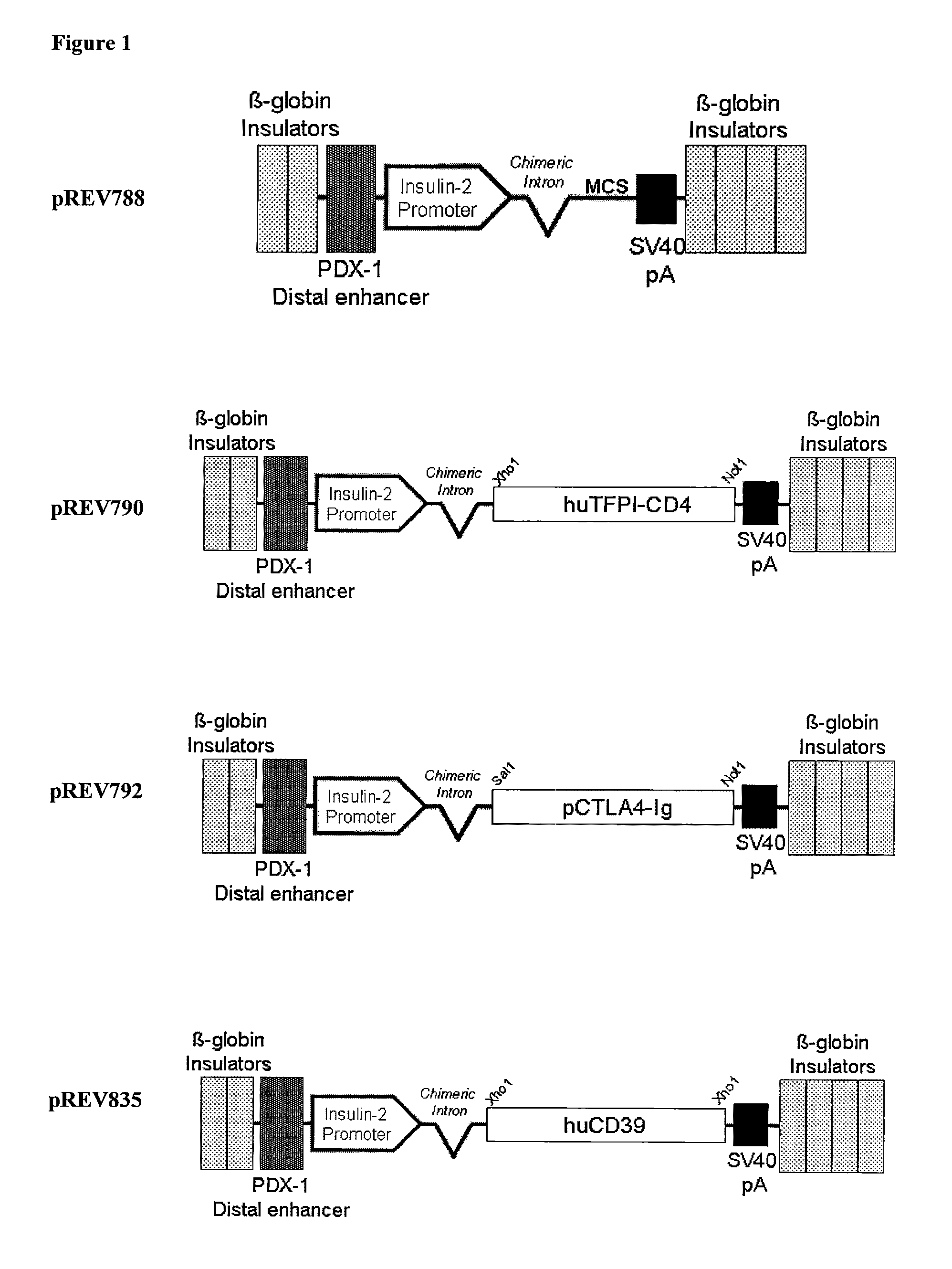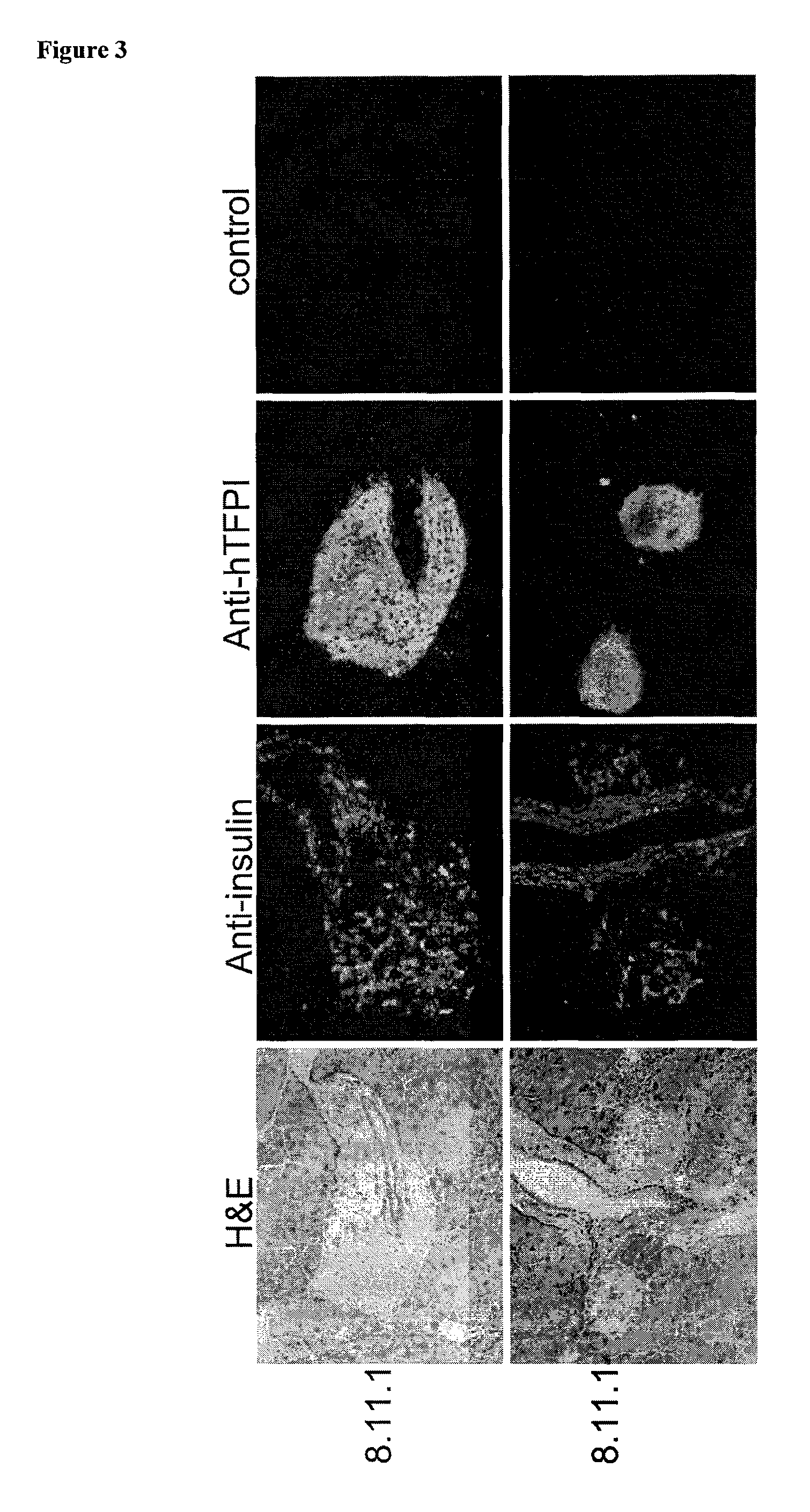Multi-transgenic pigs for diabetes treatment
a multi-transgenic, pig technology, applied in the field of donors, tissues and cells, can solve the problems of blindness, heart disease, kidney disease, even death, and the difficulty of achieving tight glycemic control using insulin replacement therapy, and achieve the effect of reducing the need for long-term immunosuppressant or anti-coagulant therapy, and being particularly useful for xenotransplantation therapies
- Summary
- Abstract
- Description
- Claims
- Application Information
AI Technical Summary
Benefits of technology
Problems solved by technology
Method used
Image
Examples
example 1
Islet-Specific Expression Vector Construction
[0326]The mammalian expression vector pCI-Neo (Promega) sewed as a backdrop for the pancreatic islet-specific expression cassette. This vector was modified by a Cla1 excision of a 1967 base pair (bp) fragment containing the phage f1 region, the SV40enhancer and early promoter, the SV40 minimum origin of replication, and the neomycin phosphotransferase gene. In addition, the CMV immediate-early enhancer / promoter was excised when the insulin-II promoter was inserted into this vector using restriction enzymes BglII and Hind III.
[0327]A choice of sequence to serve as the promoter element for the pancreas specific expression vector was made by comparison of two cloned sequences amplified from the proximal sequence upstream of the rat insulin II gene CDS. These amplified products varied in length from 497 bp to 767 bp; the shortest amplified product most closely corresponded to that used previously in the literature. To determine which promoter...
example 2
Production of TFPI Transgenic Mice with Pancreas-Specific Expression Vector pREV790
[0349]Zygote stage mouse embryos were obtained from B6C3 F1 females mated to B6C3 F1 males (Harlan Sprague Dawley, Dublin, Va.). The females were superovulated with 7.5 IU PMSG (i.p., Calbiochem, San Diego, Calif.) and 5.0 IU Hcg (i.p., Intervet, Millsboro, Del.) 44 to 48 h later. Zygotes were collected and manipulated by standard methods (Hogan et al., 1994) in FHM (Specialty Media, Lavallette, N.J.). In vitro embryo culture was done in KSOM medium (Specialty Media) at 37° C. with 5.0% CO2 in humidified air. Pronuclear microinjection of the pREV790 construct was performed using methods described previously (Page et al., 1995 Transgenic Res. 4:12-17). Injected embryos were cultured in vitro overnight, at which time they were removed from KSOM and placed into FHM. Viable two-cell embryos were transferred into the oviducts of pseudo pregnant ICR mice (Harlan Sprague Dawley) using known techniques (Hogan...
example 3
Cell Line Preparation for Nuclear Transfer
Isolation of Cell Lines:
[0351]Two cell lines (183-6-6 and 227-3) were used as the genetic background for transfections to add the additional transgenes, and ultimately for nuclear transfer to generate pigs. Both cell lines were produced by breeding of GTKO pigs (Dai et al., (2002) Nature biotechnology 20, 251-255; Phelps et al., Science, (2003) 299:411-414) with ubiquitously expressing hCD46 transgenic pig lines (Loveland et al., Xenotransplantation, 2004, 11:171:183). Both cell lines were confirmed by genotype and phenotype as homozygous GTKO and hCD46 transgenic. The cell lines were prepared for use in NT as follows: A fetal fibroblast cell line was isolated from fetus 183-6-6 at day 36 of gestation. The Fetus was mashed through a 60-mesh metal screen using curved surgical forceps slowly so as not to generate excessive heat. The cell suspension was then pelleted and resuspended in DMEM containing 20% fetal calf serum and Antibiotic-Antimyc...
PUM
| Property | Measurement | Unit |
|---|---|---|
| diameter | aaaaa | aaaaa |
| diameter | aaaaa | aaaaa |
| diameter | aaaaa | aaaaa |
Abstract
Description
Claims
Application Information
 Login to View More
Login to View More - R&D
- Intellectual Property
- Life Sciences
- Materials
- Tech Scout
- Unparalleled Data Quality
- Higher Quality Content
- 60% Fewer Hallucinations
Browse by: Latest US Patents, China's latest patents, Technical Efficacy Thesaurus, Application Domain, Technology Topic, Popular Technical Reports.
© 2025 PatSnap. All rights reserved.Legal|Privacy policy|Modern Slavery Act Transparency Statement|Sitemap|About US| Contact US: help@patsnap.com



